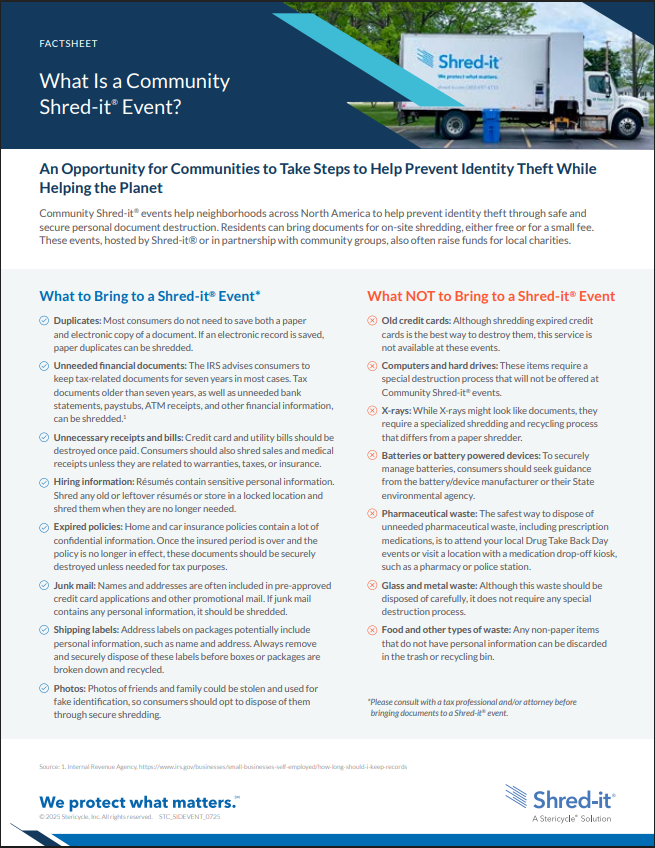July 29, 2025
Community Shred-it® Events: What to Bring and What Not to Bring
Identity theft remains a growing threat to American consumers. In 2024, 2.6 million U.S. consumers lost more than $12.5 billion to fraud – a 25% jump over 2023, according to the Federal Trade Commission. This included 1.1 million reports of identity theft – up 18% over 2023. Hijacked and newly opened bogus credit cards are the most common form of identity theft, according to Experian.
Disposing of documents containing personally identifiable information, such as name, address, financial details, bank account numbers, and Social Security information, in the trash or recycling bin, can elevate the risk of physical data theft. “Dumpster divers” can steal these documents from the trash and use them to commit crimes, such as withdrawing money, getting a credit card or car loan, opening a utility account, stealing tax refunds, and accessing medical care.
Community Shred-it® events offer a secure solution for destroying sensitive personal information, helping mitigate the risk of identity theft.
Community Shred-it® Events Help Protect Confidential Information and the Environment
Throughout the year, Shred-it® hosts Community Shred-it® events, which promote information security and sustainability in local neighborhoods. Sometimes these events are held in partnership with local businesses or community groups to raise funds for various charitable causes. They provide community members with the opportunity to have their personal documents securely destroyed by onsite shredding trucks, either for free or for a nominal fee. In addition to helping prevent identity theft, Community Shred-it® events promote sustainability, as they send all shredded documents for recycling. The impact can’t be overstated.
Shred-it® locations often partner with local non-profits to raise money during Community Shred-it® events, enabling consumers to connect with their fellow community members and support worthy local initiatives.
What to Bring to Community Shred-it® Events
Residents who attend Community Shred-it® events should bring any paper documents containing personal information. Examples include:
- Old Financial Documents: If not needed for tax purposes, documents containing financial information should be securely destroyed. The IRS advises retaining tax-related documents for up to seven years.
- Shipping Labels: Shipping labels often contain personal information, including names and addresses.
- Photos: Photos can be misused for creating fake identification.
- Duplicates: If the information is stored electronically or in another document, the copies should be shredded.
Professional shredding services, like Shred-it®, use cross-cut shredding equipment to reduce paper to confetti-like pieces that are impossible to reassemble. This method is significantly more effective than home shredders and do-it-yourself methods, which produce long strips of paper that could potentially be reconstructed by thieves and fraudsters.
What Items Not to Bring to Community Shred-it® Events
Community Shred-it® events are limited to paper document shredding services. Please refrain from bringing the following items:
- Hard Drives: These require a specialized destruction process that is not part of the services provided at Community Shred-it® events. However, Shred-it® is pleased to offer hard drive destruction services to businesses and individuals at selected locations. For more information on availability, please contact us directly.
- Batteries or Battery Powered Devices: For secure disposal, please consult the manufacturer of your battery or device.
- Medical Waste: To dispose of pharmaceutical waste, consider attending your local Drug Take Back Day event. Additionally, for other medical waste disposal options, please contact your local government offices.
Alternatives if You Can't Attend a Community Shred-it® Event
If you are unable to attend a Community Shred-it® event or if there is not one scheduled in your area, Shred-it® offers several other convenient service options:
- Residential shredding*: Shred-it® will collect documents directly from your residence.
- Drop-off shredding*: Bring your documents to a local Shred-it® office for secure disposal.
- Mobile shredding*: Shred-it® will come to your business to collect documents for shredding.
Learn more about Community Shred-it® events by downloading our infographic and visit our Community Shred-it® events page.
*Contact Shred-it® for service availability.
**This article is for general information purposes only and should not be construed as legal advice on any specific facts or circumstances.
